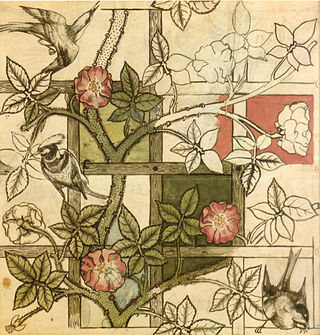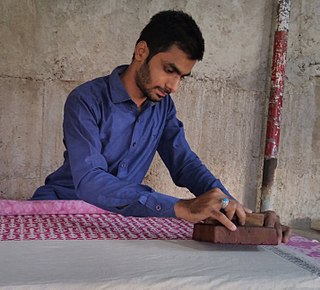
The Arts and Crafts movement was an international trend in the decorative and fine arts that developed earliest and most fully in the British Isles and subsequently spread across the British Empire and to the rest of Europe and America.

A handicraft, sometimes more precisely expressed as artisanal handicraft or handmade, is any of a wide variety of types of work where useful and decorative objects are made completely by one's hand or by using only simple, non-automated related tools like scissors, carving implements, or hooks. It is a traditional main sector of craft making and applies to a wide range of creative and design activities that are related to making things with one's hands and skill, including work with textiles, moldable and rigid materials, paper, plant fibers, clay, etc. One of the oldest handicraft is Dhokra; this is a sort of metal casting that has been used in India for over 4,000 years and is still used. In Iranian Baluchistan, women still make red ware hand-made pottery with dotted ornaments, much similar to the 5,000-year-old pottery tradition of Kalpurgan, an archaeological site near the village. Usually, the term is applied to traditional techniques of creating items that are both practical and aesthetic. Handicraft industries are those that produce things with hands to meet the needs of the people in their locality without using machines.

Thorstein Bunde Veblen was an American economist and sociologist who, during his lifetime, emerged as a well-known critic of capitalism.

A craft or trade is a pastime or an occupation that requires particular skills and knowledge of skilled work. In a historical sense, particularly the Middle Ages and earlier, the term is usually applied to people occupied in small scale production of goods, or their maintenance, for example by tinkers. The traditional term craftsman is nowadays often replaced by artisan and by craftsperson.

A Veblen good is a type of luxury good, named after American economist Thorstein Veblen, for which the demand increases as the price increases, in apparent contradiction of the law of demand, resulting in an upward-sloping demand curve. The higher prices of Veblen goods may make them desirable as a status symbol in the practices of conspicuous consumption and conspicuous leisure. A product may be a Veblen good because it is a positional good, something few others can own.

The Theory of the Leisure Class: An Economic Study of Institutions (1899), by Thorstein Veblen, is a treatise of economics and sociology, and a critique of conspicuous consumption as a function of social class and of consumerism, which are social activities derived from the social stratification of people and the division of labor; the social institutions of the feudal period that have continued to the modern era.
Institutional economics focuses on understanding the role of the evolutionary process and the role of institutions in shaping economic behavior. Its original focus lay in Thorstein Veblen's instinct-oriented dichotomy between technology on the one side and the "ceremonial" sphere of society on the other. Its name and core elements trace back to a 1919 American Economic Review article by Walton H. Hamilton. Institutional economics emphasizes a broader study of institutions and views markets as a result of the complex interaction of these various institutions. The earlier tradition continues today as a leading heterodox approach to economics.
Technocracy is a form of government in which the decision-makers are selected based on their expertise in a given area of responsibility, particularly with regard to scientific or technical knowledge. Technocracy follows largely in the tradition of other meritocracy theories and assumes full state control over political and economic issues.
Software craftsmanship is an approach to software development that emphasizes the coding skills of the software developers. It is a response by software developers to the perceived ills of the mainstream software industry, including the prioritization of financial concerns over developer accountability.

American Craftsman is an American domestic architectural style, inspired by the Arts and Crafts movement, which included interior design, landscape design, applied arts, and decorative arts, beginning in the last years of the 19th century. Its immediate ancestors in American architecture are the Shingle style, which began the move away from Victorian ornamentation toward simpler forms, and the Prairie style of Frank Lloyd Wright.
The Theory of Business Enterprise is an economics book by Thorstein Veblen, published in 1904, that looks at the growing corporate domination of culture and the economy.
The Seal of Excellence for Handicrafts is awarded to handicraft products annually by UNESCO.
George Washington Henry Jack was a British Arts and Crafts designer and architect. Born in America, he grew up and trained in Scotland, before moving south to join the office of Philip Webb. A contemporary of William Morris, Jack designed furniture for Morris & Co., and was a member of the Art Workers Guild and the Arts and Crafts Society. After the turn of the 20th century, he set up his own practice, which continued until his death.
The Arts and Crafts Exhibition Society was formed in London in 1887 to promote the exhibition of decorative arts alongside fine arts. The Society's exhibitions were held annually at the New Gallery from 1888 to 1890, and roughly every three years thereafter, were important in the flowering of the British Arts and Crafts Movement in the decades prior to World War I.

The crafts of India are diverse, rich in history, culture and religion. The craft of each state in India reflect the influence of different empires. Throughout centuries, crafts have been embedded as a culture and tradition within rural communities.

The Kosovan city of Gjakova has been populated since the prehistoric era. During the medieval period, in 1485, Gjakova is mentioned as a village, concretely as a market place.
Gjakova served as a trading center on the route between Shkodër and Istanbul.
The Canadian Handicrafts Guild was an association of Canadians involved in handicrafts that was founded in Montreal in 1906. At first the goal was to preserve and market traditional home crafts that were seen as being at risk of dying out. Demand for high quality products and a shift towards more "professional" craftspeople and modern designs placed stress on the organization. In 1967 the provincial branches became autonomous, and subsequently evolved separately. At the national level the Guild was merged with the Canadian Craftsman's Association in 1974 to form the Canadian Crafts Council, now the Canadian Crafts Federation.
Pride of workmanship is the gratifying sense of having done good work. It is an element of job satisfaction. One of the key principles in the philosophy of management consultant W. Edwards Deming is that workers have a right to pride of workmanship:
- Remove barriers that rob the hourly worker of his right to pride of workmanship. The responsibility of supervisors must be changed from sheer numbers to quality.
- Remove barriers that rob people in management and in engineering of their right to pride of workmanship. This means, inter alia, abolishment of the annual or merit rating and of management by objective.

Handicrafts produced during the Qing dynasty (1644–1911) were objects designed and hand-made by craftsmen. They were heavily ornate, incorporating Tibetan, Middle Eastern, Indian, and European techniques. The design or decorative aspect of the craft was as important as the crafting technique itself and Qing artisans were particular about the materials they used, such as jade (yu), stones, and wood. In their designs artisans drew heavily from a number of motifs, both mythical and natural. Certain areas in China became well-known for specific types of handicrafts; for example, Jingdezhen was known as the capital of porcelain. During the Qing era, Imperial Workshops built in Beijing brought together artisans and raw materials that were once only obtainable in disparate regions. This allowed for the combining of technologies and materials to produce new types of handicrafts. The tributary system also brought new sources for materials and artisans that were not from the production centers.










